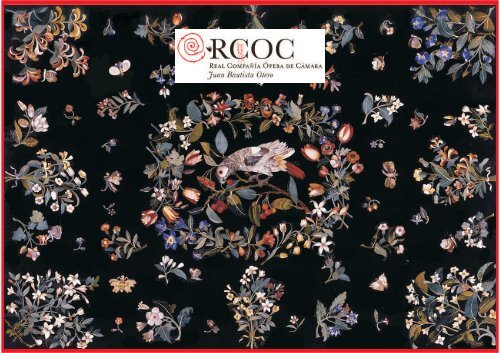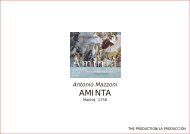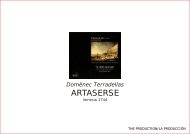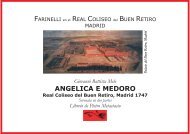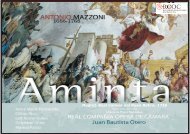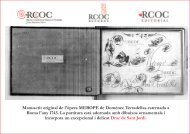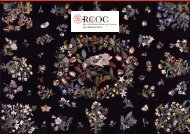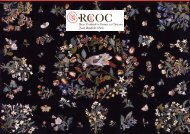You also want an ePaper? Increase the reach of your titles
YUMPU automatically turns print PDFs into web optimized ePapers that Google loves.
REAL COMPAÑÍA ÓPERA DE CÁMARA<br />
Juan Bautista Otero<br />
PRÉSENT<br />
Bernardo Bellotto: Veduta di Vienna from Belvedere
MARTÍN y <strong>SOLER</strong><br />
CANTATES POUR L'EMPEREUR<br />
CANTATES SCÉNIQUES COMPLETES<br />
I<br />
LA DORA FESTEGGIANTE<br />
Torino, 1783<br />
Livret de Cesare Olivieri<br />
II<br />
<strong>IL</strong> <strong>SOGNO</strong><br />
Vienna, 1789<br />
Livret de Lorenzo Da Ponte
I<br />
LA DORA FESTEGGIANTE
CANTATE SCÉNIQUE<br />
Livret original de Cesare Olivieri<br />
Torino, 1783<br />
PREMIÈRE EN FRANCE<br />
PREMIER ENREGISTREMENT MONDIAL<br />
RCOC RECORDS-HARMONIA MUNDI<br />
LA DORA FESTEGGIANTE
Dramatis Personae<br />
APOLLO, soprano<br />
Sunhae Im<br />
PALLADE, soprano<br />
Verónica Cangemi<br />
GIOVE, tenore<br />
Magnus Staveland
II<br />
<strong>IL</strong> <strong>SOGNO</strong>
<strong>IL</strong> <strong>SOGNO</strong><br />
CANTATE SCÉNIQUE<br />
Livret original de Lorenzo Da Ponte<br />
Vienne, 1789<br />
PREMIÈRE EN FRANCE<br />
PREMIER ENREGISTREMENT MONDIAL<br />
RCOC RECORDS-HARMONIA MUNDI
Dramatis Personae<br />
NICE, soprano<br />
Sunhae Im<br />
EGLE, soprano<br />
Verónica Cangemi<br />
F<strong>IL</strong>ENO, tenore<br />
Magnus Staveland
Ada Pesch, Premier Violon<br />
Mary Utiger, Violino I<br />
Emanuele Marcante, Violino I<br />
Gabriele Steinfeld, Violino I<br />
Andreas Preuss, Violino II<br />
Mihoko Kimura, Violino II<br />
Vassilios Tsotsolis Violino II<br />
Christophe Timpe, Violino II<br />
Galina Zinchenko, Viola<br />
Marcial Moreiras, Viola<br />
Giovanna Barbati, Violoncello<br />
Roberto Alonso, Violoncello<br />
Juan Jaime Ruíz, Contrabasso<br />
Charles Zebley, Traverso I<br />
Serge Saitta, Traverso II<br />
Michael Bosch, Oboe I<br />
Anna Starr, Oboe II<br />
Diego Montes, Clarinetto I<br />
Philippe Castejón, Clarinetto II<br />
Rhoda Patrick, Fagotto I<br />
Eckhard Lenzing, Fagotto II<br />
Uli Hübner, Corno I<br />
Renée Allen, Corno II<br />
Hans Martin Rux Tromba I<br />
Almut Rux Tromba II<br />
Stefan Gawlick, Timpani<br />
Marta Graziolino, Arpa<br />
Benoît Hartoin,<br />
Fortepiano/Cembalo
MARTÍN y <strong>SOLER</strong><br />
(Valencia 1754- Saint Petersburg 1806)
Martín y Soler<br />
Les Cantates Scéniques pour l'Empereur<br />
Vicente Martín y Soler (Valencia, 2 May 1754-St. Petersburg, 30 January 1806) composed over 30 operas and around 20 ballets<br />
for the leading theatres in Europe, including the Teatro di San Carlo, Naples, the Burgtheater, Vienna, the Hermitage, St.<br />
Petersburg and the King’s Theatre, London.<br />
His works were performed by some of the most of the renowned singers of the time (the castrato Luigi Marchesi, the tenors<br />
Giovanni Ansani and Michael Kelly, the sopranos Maria Balducci, Luisa Todi and Nancy Storace) and the prestigious<br />
choreographers with whom he worked included Charles Lepicq and Domenico Rossi.<br />
He served the most powerful figures of Europe during the Age of Enlightenment: he was the royal favourite of the Emperor Joseph<br />
II of Austria, Catherine of Russia and her brother Paul I, as well as Philip, Duke of Parma, and Ferdinand I of Naples.<br />
And if that wasn’t enough, he collaborated with some of the most brilliant librettists from the last quarter of the eighteenth<br />
century, from Lorenzo Da Ponte and Luigi Serio to the revolutionary Moretti and Cigna-Santi.<br />
He visited such notable figures as Haydn, Mozart, Salieri, Mariana Martínez, the sculptor Antonio Canova, and Vigée-Lebrun.<br />
Yet today, Martín y Soler remains largely unknown to audiences.<br />
Like Martín, Da Ponte maintained a spirit of social criticism as well as a continuous urge for innovation throughout his entire career. In<br />
his own writings he declared the primordial objective of his librettos was to employ consolidated literary genres –such as pastoral<br />
poetry or Goldonian drama– to introduce new musical, literary, social and philosophical ideas. He used the majority of the creative<br />
resources from his ballets and opere serie to serve the dramma giocoso. As a result were the resounding successes of his Viennese<br />
operas: Il burbero di buon cuore, 20 performances, Una cosa rara, 55 and L’Arbore di Diana, 65. Once again, it is worth stressing that he<br />
had the best performers at his disposal. The cast of Una cosa rara and Diana consisted of some of the same singers who premiered<br />
Mozart’s Le nozze di Figaro, Don Giovanni and Così fan tutte including the sopranos Nancy Storace, Luisa Laschi, Anna Morichelli, the<br />
tenors Michael Kelly, Vincenzo Calvesi and the baritone Stefano Mandini.<br />
The formal innovations he incorporated into his dramme giocosi and scenic cantatas included the propulsion of the beginning of the<br />
story with a vigorous ensemble composition. This can be seen in the terzetto “Zitto, zitto non parlate” from Diana or the three- and<br />
four-part introductions to Una cosa rara and Il burbero, instead of the recitative secco of the opere serie. Divided into two acts, with<br />
many very expressive ensemble parts, short arias and long finales, Martín’s works were also characterised by the incorporation of<br />
rhythmic-melodic forms deriving from the Spanish seguidilla. These melodies recalled the carmagnoles of the French Revolution and<br />
harmonic progressions more typical of Schubertian Lied than of classical opera. On the other hand, many of the features of his dramme<br />
giocosi are marked by elements more characteristic of tragicomedies: Endimione, the Prince, Silvio and Clizia, always present the<br />
contrast between the dignity of their mythical origins or high social standing, and the fragility of their reactions. They are not<br />
completely buffo characters; this can be seen in the arias “Più bianca” and “Liete e amorosi i rai”, sung by the Prince and Endimione,<br />
respectively. The elegiac, precious, porcelain-like delicate treatment of the latter coincides with the personality of the noble shepherd,<br />
the personification of the eternal dream, the silver-lined kiss of the moon, so exalted by poets.<br />
Martín y Soler undoubtedly represented the avant-garde at the end of the eighteenth century. His extraordinary works raise questions,<br />
but don’t seem to provide responses to that transgression of the idyllic… How much had been written about Arcadia until then? Yet here,<br />
the oneiric is the carnal, and Martín y Soler’s output is revealed in the guise of a troubled man still without a response, though open to a<br />
new conception of humanity at the dawn of the nineteenth century, which is so applicable today.
PROGRAMME<br />
Martín y Soler<br />
(1754-1806)<br />
Cantates scéniques pour l'empereur<br />
Prémier Partie<br />
LA DORA FESTEGGIANTE<br />
Torino, 1783<br />
Livret de Cesare Olivieri<br />
15 minutes de Pause<br />
Deuxième Partie<br />
<strong>IL</strong> <strong>SOGNO</strong><br />
Vienna, 1789<br />
Livret de Lorenzo Da Ponte<br />
Juan Bautista Otero, direction<br />
Isidro Olmo, direction adjointe<br />
Otero-Olmo, dramaturgie et édition<br />
REAL COMPAÑÍA ÓPERA DE CÁMARA<br />
3 solists and 28 musiciens<br />
durée aprox.:<br />
1 heure 30 minutes<br />
une pause of 15 minutes
La Real Compañía Ópera de<br />
Cámara de Barcelona- RCOC- es<br />
una orquesta barroca integrada<br />
en una plataforma independiente<br />
de creación operística, fundada<br />
por el director de orquesta y<br />
musicólogo, Juan Bautista<br />
Otero junto al director de<br />
escena Isidro Olmo.<br />
RCOC emula la experiencia<br />
realizada por el célebre castrato<br />
Farinelli cuando, desde su cargo<br />
de director de los<br />
entretenimientos reales, fundó<br />
por vez primera en la historia de<br />
nuestro país, la primera orquesta<br />
de ópera de cámara con carácter<br />
itinerante que acompañaba a la<br />
corte en sus continuos<br />
desplazamientos por los Reales<br />
Sitios.<br />
RCOC,<br />
centra su actividad en la<br />
recuperación del patrimonio<br />
musical español y de los antiguos<br />
reinos borbónicos en Italia<br />
durante el siglo XVIII, con<br />
especial significación en la<br />
música escénica. Admiramos la<br />
maestría de la técnica<br />
compositiva nacida de la escuela<br />
napolitana y de sus más<br />
significativos miembros: Martín y<br />
Soler, David Pérez, Domingo<br />
Terradellas, Mariana Martínez,<br />
Nicola Porpora, Domenico<br />
Scarlatti y otros. RCOC dispone<br />
de una sección editorial<br />
compuesta de títulos de<br />
extraordinario valor que, en su<br />
mayoría, no han sido publicados<br />
por ninguna otra editorial.<br />
La Real Compañía Ópera de<br />
Cámara se ha posicionado como<br />
una de las orquestas barrocas<br />
españolas de mayor prestigio, en<br />
el exclusivo panorama de la<br />
música antigua, gracias a su<br />
labor concertante y escénica y<br />
también a las exitosas<br />
grabaciones de RCOC aparecidas<br />
en el mercado mundial:<br />
Orlando,<br />
de Nicola Porpora,<br />
Ifigenia in Aulide,<br />
de Martín y<br />
Soler y Aminta, il rè pastore,<br />
de Antonio Mazzoni, encargo<br />
expreso de Farinelli para ser<br />
representado en el Real Coliseo<br />
del Buen Retiro de Madrid en<br />
ocasión del aniversario de<br />
Fernando VI de Borbón.<br />
Las tres grabaciones constituyen<br />
auténticas efemérides por ser<br />
estrenos mundiales absolutos<br />
desde su composición en el siglo<br />
XVIII. Así Orlando, realizada en<br />
ocasión del 300 aniversario del<br />
fallecimiento de Farinelli y con<br />
cuya ópera debutó como cantante<br />
en los escenarios napolitanos;<br />
Ifigenia in Aulide, rescatada en<br />
ocasión del 250 aniversario del<br />
compositor valenciano, constituye<br />
la primera y única grabación de<br />
una de sus óperas serias así<br />
como la única grabación<br />
operística sobre el compositor<br />
realizada en el 2006, año de su<br />
conmemoración; Aminta, il rè<br />
pastore<br />
es la primera grabación<br />
mundial del largo y fructífero<br />
período de Farinelli en España.<br />
The Real Compañía Ópera de<br />
Cámara- RCOC- of Barcelona is<br />
an independent operatic ensemble<br />
performing on periodinstruments,<br />
created by the<br />
conductor and musicologist Juan<br />
Bautista Otero and the stage<br />
producer Isidro Olmo.<br />
RCOC evokes the unique<br />
experience carried out by the<br />
acclaimed castrato Farinelli<br />
when, as director of the royal<br />
entertainments in Spain, founded<br />
the first royal chamber opera<br />
orchestra which toured with the<br />
king and the court to all their<br />
royal palaces.<br />
RCOC focuses its activity on the<br />
rediscovery of the musical<br />
heritage related to Spain and the<br />
old Bourbon kingdoms in Italy<br />
during the eighteenth century,<br />
specially concerning the music for<br />
the stage of the neapolitan<br />
operatic masters as David Pérez,<br />
Domingo Terradellas, Domenico<br />
Scarlatti, Mariana Martínez or<br />
Martín y Soler.<br />
RCOC has its own editorial<br />
department devoted to the<br />
publication of works already<br />
produced by the company or<br />
planned for future performance.<br />
Its catalogue consists of<br />
extremely valuable titles, most of<br />
which have never been published<br />
by any other music firm in the<br />
world.<br />
The Real Compañía Ópera de<br />
Cámara is nowadays one of the<br />
most prestigious spanish baroque<br />
orchestras thanks to the<br />
successful stage productions<br />
carried out in the last years and<br />
the recently appeared world<br />
premiere recordings, distributed<br />
worldwide: Nicola Porpora’s<br />
Orlando,<br />
Martín y Soler’s<br />
Ifigenia in Aulide,<br />
and Antonio<br />
Mazzoni’s Aminta, il rè pastore,<br />
commisioned from Farinelli for the<br />
Royal Theater of Buen Retiro in<br />
Madrid, to celebrate king<br />
Ferdinand VI of Bourbon<br />
anniversary in 1756.<br />
Orlando, the piece with which<br />
Farinelli appeared for the first<br />
time on the stage in Naples, was<br />
produced on occasion of the<br />
300th anniversary of Farinelli.<br />
Ifigenia in Aulide, rediscovered<br />
and produced to celebrate in 2006<br />
the year of Martín y Soler,<br />
constitutes the first recording until<br />
now of one of his opera serias and<br />
at the same time it has been the<br />
only opera appeared in 2006 to<br />
celebrate his 250th anniversary.<br />
Aminta, il rè pastore is the first<br />
world recording of an opera<br />
belonging to the wide and fruitful<br />
period of Farinelli in Spain.
REAL COMPAÑÍA ÓPERA DE CÁMARA<br />
C, Tallers 22 2-2 08001 BARCELONA<br />
TELF/FAX 00.34.93.317.06.87<br />
WWW.RCOC-ORQUESTA.COM<br />
Produccion@rcoc-orquesta.com


